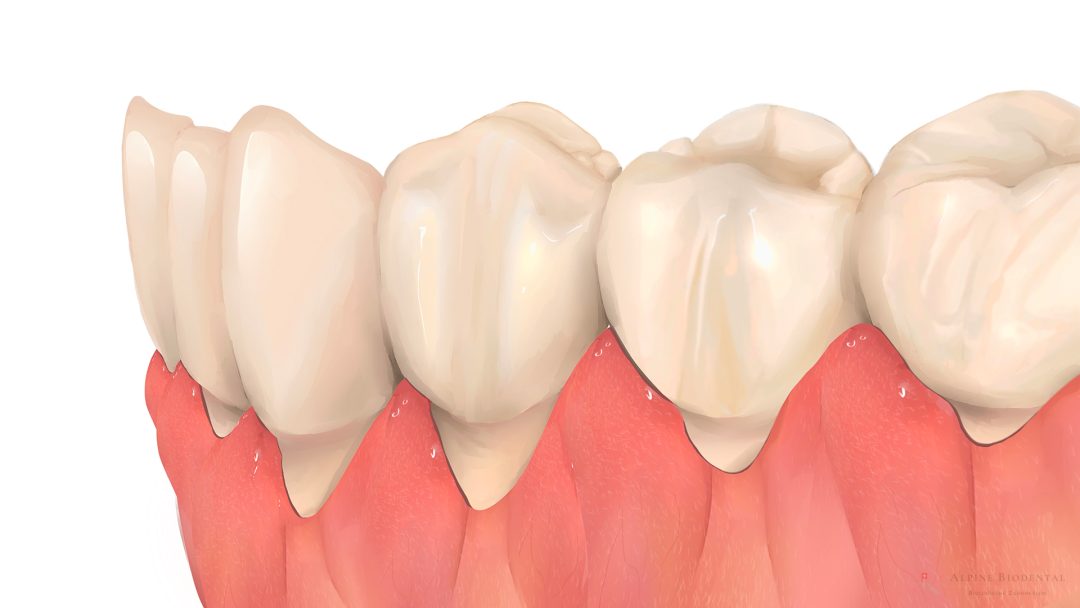Periodontitis

Periodontitis is a widespread disease of the supporting structures of the teeth and is commonly referred to as periodontosis or gum disease in colloquial terms. Individuals affected by periodontitis experience symptoms such as gum bleeding, receding gums, and ultimately tooth loss. The primary cause of periodontitis is an unhealthy oral flora. When periodontitis occurs around a dental implant, it is referred to as peri-implantitis.
In this article, the terms periodontosis and periodontitis are used interchangeably. While the term periodontosis is outdated and colloquial, it is frequently used by patients, and we integrate it into the text.
Definitions of Periodontitis & Periodontosis
Periodontitis and periodontosis describe the same condition: the inflammatory disease of the tooth-supporting structures (periodontium, tooth bed).
The medically accurate term is periodontitis and should ideally be used. The term periodontosis, on the other hand, is outdated and colloquial but has become widely accepted in popular language.
Diagnosis and Stages of Periodontosis
The diagnosis of periodontosis in a dental practice includes a clinical examination with a magnifying glass and probe, and possibly the taking of X-rays. There are also innovative diagnostic methods for periodontitis, such as the determination of the enzyme ammp8 produced by granulocytes, a type of immune cells.
Periodontosis can be classified into stages or severity levels, each with different symptoms.
Mild Periodontitis in the initial Stage
Mild periodontitis is characterized by a mild inflammation of the tooth-supporting structures. The gums are red and may bleed easily upon touch or brushing. At this stage, there is no bone loss around the affected teeth.
Moderate Periodontitis
The inflammation of the tooth bed continues, gum pockets and bone pockets around the teeth form, and teeth often show slight loosening. Patients may observe increased gum recession and seek dental attention.
Advanced Periodontitis
Advanced periodontitis, also known as severe periodontitis, exhibits severe signs of inflammation. This stage leads to significant gum recession, tooth loosening, and bone loss with pockets around the teeth. Often, this stage culminates in tooth loss. Complete healing of advanced periodontosis is not possible.
Causes of Periodontitis or Periodontosis
The core cause of periodontitis is an unhealthy oral flora with a high concentration of periodontitis bacteria. These bacteria are highly aggressive, penetrating gum pockets and breaking down the tissue anchoring the teeth (periodontium or tooth bed). The immune system responds with local inflammation to defend against the invaders, resulting in an inflammatory process.
These pathological microbes can enter the bone and bloodstream from the gum pockets, causing systemic symptoms and significantly compromising health.
Oral Flora
A high concentration of periodontitis bacteria in the oral flora predisposes individuals to periodontitis. These bacteria break down the collagen fibers anchoring the teeth in the jawbone. These bacteria are anaerobic and perish when exposed to higher concentrations of oxygen. Since deep gum pockets have a lower oxygen level and higher CO2 concentration, it is understandable why problematic bacteria thrive there. Building a healthy oral flora is crucial to eliminate these bacteria.
Poor Oral Hygiene
In cases of poor oral hygiene where dental plaques are not removed, harmful bacteria multiply rapidly, leading to a significant increase in periodontosis. Bacterial plaques provide ideal conditions for the progression of periodontosis.
At Alpine BioDental, we prioritize a healthy tooth-supporting structure, combining effective dental hygiene with plasma medicine. Targeted application of plasma and ozone floods the gum pockets with oxygen molecules and ions. Significant improvement in periodontal tissues is observed after just one session.
Calculus and Tartar
Bacteria that penetrate gum pockets also accumulate on the teeth, forming dental plaques. Over time, these plaques harden, creating a rough surface that irritates the tooth-supporting structure and worsens periodontosis. This hardened dental plaque is known as calculus or tartar and should be gently removed by a dentist, ensuring minimal tissue damage.
Smoking
Smoking increases CO2 concentration in the mouth and decreases oxygen levels, providing ideal living conditions for causal bacteria. It is an additional factor that impacts the core cause (oral flora).
Malnutrition
Malnutrition disrupts the balance of the immune system, leading to either excessive reactions or weakening. This imbalance can facilitate rapid progression of periodontitis. Additionally, malnutrition affects the optimal structure of the tooth-supporting structure, leading to swift destruction, as seen in vitamin C deficiency (scurvy).
Other Factors
Various general conditions such as diabetes, different chemicals and medications, or stress can also negatively influence periodontosis. However, with proper attention to a stable oral flora, these influences can be effectively compensated.
Symptoms and Signs of Periodontitis
The symptoms of periodontitis can be divided into local symptoms, directly in the area of the teeth, and generalized symptoms, which can become noticeable throughout the entire body. The local symptoms are usually noticed first by the patient.
The local symptoms and signs of periodontitis can manifest themselves in bleeding gums, receding gums, pain in the teeth, loosening of the teeth and ultimately tooth loss.
The systemic symptoms of periodontitis can be very varied. Links have been established with arteriosclerosis, diabetes, arthritis, rheumatism and osteoporosis. However, non-specific symptoms such as fatigue can also be observed.
Local Symptoms of Periodontitis
Local symptoms are limited to the tooth-supporting structures (periodontium), the tissue anchoring the tooth in the jawbone. Patients often complain of varying degrees of pain, ranging from acute (painful) to chronic (persistent and less painful), depending on the condition.
Gingivitis
Gingivitis, inflammation of the gums, almost always precedes periodontitis. The gums appear swollen and bluish-red. They quickly bleed upon touch or brushing and can be painful.
Gum Bleeding
Gum bleeding is a classic local symptom that almost always occurs in periodontitis. A healthy gum should not bleed during gentle probing. Patients often notice gum bleeding during brushing, which is an early sign of existing periodontitis. Bacterial plaques, often unremoved by patients, are commonly found in highly inflamed and bleeding areas.
Pain in Periodontitis
Especially in acute phases of periodontitis, tooth pain may occur. However, periodontitis is often chronic, and pain is less frequent. In some patients, periodontitis progresses rapidly, leading to tooth loss without accompanying pain.
Bone loss and Gum recession
Periodontitis results in the breakdown of the entire tooth-supporting structure, evident through bone loss and gum recession. The dentist can detect bone loss through clinical examination and X-rays. Gum recession is observed when more of the tooth is visible, and exposed tooth roots become apparent.
Bad Breath
Bad breath is not exclusive to patients with periodontosis but is more pronounced and frequent in them. Therefore, bad breath is included in the list of local symptoms.
Systemic Symptoms of Periodontitis
Periodontitis has systemic effects on the entire body, causing physical symptoms and significantly impacting health. Thus, periodontitis should be treated not only to preserve teeth but also to maintain overall health.
The systemic burden has two main reasons:
- Harmful periodontal bacteria penetrate the bone and bloodstream through inflamed gum pockets, spreading throughout the body and causing various symptoms.
- Local inflammation and invaded bacteria prompt the immune system to flood the body with inflammatory mediators. This triggers inflammatory cascades that can influence each other, leading to different inflammatory diseases.
Arteriosclerosis
In blood vessels, the immune system attempts to combat invading bacteria by depositing them in fat and calcium, rendering them harmless. This process increases the formation of plaques in vessels, narrowing them. Arteriosclerosis can ultimately result in stroke and heart attack later in life.
Diabetes Mellitus
Studies show clear links between periodontitis and diabetes mellitus. The impact on the pancreas is particularly significant in patients with advanced or severe and prolonged periodontitis.
Arthritis and Rheumatism
Arthritis and rheumatism, inflammatory joint diseases, result from inflammatory cascades and bacterial invasion. As long as stabilization of periodontitis is not achieved, symptoms often persist, leading to ongoing degradation.
Osteoporosis
Prolonged inflammation leads to body acidification. In response, the body starts breaking down bone tissue to buffer acids, releasing mineral ions. These minerals have a good buffering property, neutralizing acids. This process weakens the bone structure, leading to the development of osteoporosis.
For more information on holistic and systemic influences from the mouth and jaw, please read articles on holistic dentistry and environmental dentistry.
Treatment of Periodontitis or Periodontosis
Periodontitis treatment, also known as periodontal treatment, should address the root cause of the disease by eliminating harmful periodontitis bacteria. Therefore, the foundation of successful and lasting periodontosis treatment is building a healthy oral flora.
To eliminate harmful bacteria, it is optimal to use oxygen compounds such as ozone.
Additionally, calculus and tartar should be removed, and the patient should maintain good oral hygiene.
Quitting smoking and adopting a healthy diet are self-evident steps.
If a correctly conducted periodontitis treatment is initiated promptly, the condition is curable and highly treatable. However, if treatment is delayed until the advanced stage, permanent damage to the teeth may occur.
Home Remedies for Periodontosis: Self-Treatment
There are some home remedies that can provide supportive relief for periodontosis. However, they are not a specific treatment for the root cause.
- Baking Soda: Rinsing the mouth with a baking soda solution several times a day can help buffer mouth acidity, keeping bacteria that produce acid in check.
- Oil Pulling with Coconut Oil or Olive Oil: Daily oil pulling can provide mild relief for periodontosis.
Since home remedies only offer symptomatic relief, a comprehensive and cause-specific treatment plan should be developed in consultation with a dentist.
Preventing Periodontosis
To prevent periodontosis, it is essential to maintain a healthy oral flora, not neglect daily oral hygiene, and follow a balanced diet.
Toothpaste and mouthwashes claiming to combat periodontosis often provide insufficient protection and may contain harmful ingredients.
Optimizing oral flora through oxygen and ozone, where harmful bacteria perish in high oxygen concentrations, is an ideal approach. We are happy to work with you to create an effective treatment plan.
Dr. med. dent. Rebekka Hueber
Periodontitis can affect one's quality of life. If you have any questions our specialists are here to help you.

Frequently asked Questions about Periodontosis
Many people suffer from periodontosis without understanding the connections of this disease. We aim to inform you as comprehensively as possible.
Both terms describe the same condition: gum disease. Periodontitis is the technically correct term, while periodontosis is the widely used, older, and colloquial term.
Correctly conducted periodontosis treatment, addressing the root cause, is not unnecessary but crucial. Prolonged periodontosis can lead to loose teeth and tooth loss, which can be prevented with timely treatment.
Yes, periodontosis is contagious because periodontosis bacteria are transmitted through saliva. Therefore, periodontosis treatment should involve both partners to prevent ongoing transmission.
Chronic periodontitis can weaken the body and is suspected to contribute to various diseases, including atherosclerosis, diabetes mellitus, arthritis, rheumatism, and osteoporosis.
Periodontosis can increase the risk of premature birth with low birth weight. It is advisable for women to address the causes of periodontitis before giving birth.
Yes, individuals with periodontitis have the corresponding oral bacteria detected in their blood.
Gingivitis, inflammation of the gums, is a type of periodontitis. It is generally a mild form of periodontitis limited to the gums, with deeper layers such as the jawbone unaffected.
Classic periodontitis almost always exhibits symptoms of gingivitis.
Further information
The information listed contains relevant topics for a better understanding.